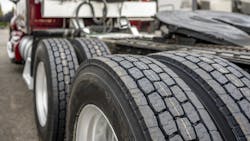There are a lot of misconceptions about load and inflation pressure. Probably the most common is the myth that the maximum pressure molded on the sidewall of a tire is necessary to carry the vehicle’s weight. That may be true in isolated applications, but in most instances, lower inflation is all that is necessary. The best place to start is with the federal regulation governing motor vehicles with a gross vehicle weight rating (GVWR) of more than 10,000 lb.
According to 49 CFR 571.120, “the sum of the maximum load ratings of the tires fitted to an axle shall be not less than the gross axle weight rating (GAWR) of the axle system as specified on the vehicle’s certification label required by 49 CFR part 567.” Some exceptions exist, but 571.120 applies to almost every commercial motor vehicle in use today.
One of the most popular sizes in the trucking industry is the 295/75R22.5 with a Load Range G. It is commonly used on tractors and trailers, so there are a wide variety of tread design options for steer, drive, and trailer positions. Regardless of the application, the 295/75R22.5 Load Range G has a maximum single load of 6,175 lb. at 110 psi and a maximum dual load of 5,675 lb. at the same inflation pressure.
If the GAWR on the front axle of a tractor is 12,350 lb., then the combined capacity of both steer tires must meet or exceed that specification. However, when 295/75R22.5 Load Range G tires are installed on steer positions, the full inflation pressure is not necessary to comply with 571.120. The GAWR on the front axle is 12,350 lb. so both steer tires must have a combined carrying capacity of at least 12,350 lb., but the inflation pressure can be less than the maximum depending on the load.
Drive and trailer axles are a little more complicated. According to 23 CFR 658.17, “the maximum gross weight upon any one axle, including any one axle or a group of axles, or a vehicle is 20,000 lb.” and “the maximum gross weight on tandem axles is 34,000 lb.” This applies to the National System of Interstate and Defense Highways, but individual states set their own limits, which cannot be less than the federal guidelines. As a result, several states have different maximum weights for single and tandem axles that are higher than those established by 658.17.
For the 295/75R22.5 Load Range G, the maximum capacity in a dual application is 5,675 lb. at 110 psi, which translates to 22,700 lb. across the axle. At maximum inflation pressure, the tires will have 2,700 lb. of additional carrying capacity on a drive or trailer axle with a GAWR of 20,000 lb. In reality, the same tires will carry 5,070 lb. at 95 psi, so the maximum inflation pressure is not necessary in order to carry the GAWR.
No one is going to dispute the effects of underinflation on treadwear and tire life. When the inflation pressure is insufficient for the load, the result will always be higher costs as tires are prematurely removed from service due to irregular treadwear or just plain fail during operation. What isn’t discussed enough is the fact that overinflation can have a similar effect on treadwear and tire life. Irregular wear patterns can be the result of too much inflation pressure for the load, while the lack of deflection in the sidewalls increases the chances for an impact break.
That being said, inflating the tire to the load provides the best conditions for optimal treadwear, but it also requires a higher level of maintenance. At 95 psi, the 295/75R22.5 Load Range G will have the capacity to support the maximum load on a 20,000-lb. axle, but the loss of just 5 psi lowers the dual tire load limit to 4,885 lb., which translates to 19,540 lb. for the axle. If the weight is split evenly between tandem axles, then each tire must support 4,250 lb., which translates to an inflation pressure of 75 psi to carry 4,300 lb.
There is a big difference between the capacity requirements in 571.120 and the actual inflation pressure in the tires. Compliance is simple math to ensure the tires are capable of supporting the GAWR. The best practice is to consult the tire manufacturer or commercial tire dealer to determine the inflation pressure that works best for each application regardless of what it says on the sidewall.
Kevin Rohlwing is the SVP of training for the Tire Industry Association. He has more than 39 years of experience in the tire industry and has created programs to help train more than 180,000 technicians.
This article originally appeared in FleetOwner.com.
About the Author

Kevin Rohlwing
Senior Vice President of Training
Kevin Rohlwing is the Senior Vice President of Training for the Tire Industry Association (TIA). He started in the tire business more than 32 years ago as a technician in his family’s dealership in Elgin, Illinois, where he also worked as a salesman and service manager.
In 1996, he joined the International Tire and Rubber Association (ITRA), the predecessor of TIA, as the Director of Commercial Tire Service. Kevin created and produced the Association’s training and certification programs that have educated more than 90,000 technicians since 1997.
In 2011, he was awarded the Silver Spark Plug for excellence in fleet maintenance from the Technology and Maintenance Council of the American Trucking Assns.
